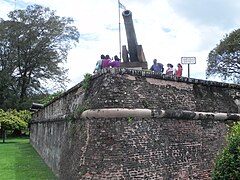Fort Cornwallis: Difference between revisions
No edit summary Tags: Mobile edit Mobile web edit |
m Reverted 4 edits by 113.210.65.146 (talk) to last revision by Acad Ronin. (TW) |
||
| Line 11: | Line 11: | ||
|Description = Engraving of Fort Cornwallis in 1804 |
|Description = Engraving of Fort Cornwallis in 1804 |
||
}} |
}} |
||
[[File:The Map of Early Penang Showing the Malay Town on the South of the Town Center by Popham 1799.jpg|thumb|right|300px|1799 map of early Penang featuring Fort Cornwallis in the northeast.]] |
[[File:The Map of Early Penang Showing the Malay Town on the South of the Town Center by Popham 1799.jpg|thumb|right|300px|1799 map of early Penang featuring Fort Cornwallis in the northeast.]] |
||
The '''Fort Cornwallis''' ([[Malay language|Malay]]: ''Kota Cornwallis'') is a [[star fort]] that the [[British East India Company]] built in the late 18th century on the northeastern coast of [[Penang Island]], [[Malaysia]]. It is named after the late 18th century Governor-General of [[Bengal]], [[India]], [[Charles Cornwallis, 1st Marquess Cornwallis]].<ref>{{cite web|title=Fort Cornwallis|url=http://www.tourism.gov.my/en/my/web-page/places/states-of-malaysia/penang/fort-cornwallis?page=/1|work=Tourism Malaysia|accessdate=22 May 2014}}</ref> Fort Cornwallis is the largest standing fort in Malaysia. In its entire history, the fort has never engaged in any battle. |
The '''Fort Cornwallis''' ([[Malay language|Malay]]: ''Kota Cornwallis'') is a [[star fort]] that the [[British East India Company]] built in the late 18th century on the northeastern coast of [[Penang Island]], [[Malaysia]]. It is named after the late 18th century Governor-General of [[Bengal]], [[India]], [[Charles Cornwallis, 1st Marquess Cornwallis]].<ref>{{cite web|title=Fort Cornwallis|url=http://www.tourism.gov.my/en/my/web-page/places/states-of-malaysia/penang/fort-cornwallis?page=/1|work=Tourism Malaysia|accessdate=22 May 2014}}</ref> Fort Cornwallis is the largest standing fort in Malaysia. In its entire history, the fort has never engaged in any battle. |
||
==History== |
==History== |
||
| Line 35: | Line 35: | ||
Image:Fort Cornwallis Eck.JPG|Seri Rambai Cannon and walls viewed from the Esplanade. |
Image:Fort Cornwallis Eck.JPG|Seri Rambai Cannon and walls viewed from the Esplanade. |
||
Image:Fort_Cornwallis_interior.jpg|Interior in February 2011 with its lighthouse in the background. |
Image:Fort_Cornwallis_interior.jpg|Interior in February 2011 with its lighthouse in the background. |
||
</gallery> |
</gallery> |
||
==Sources== |
==Sources== |
||
Revision as of 11:37, 27 June 2016

The Fort Cornwallis (Malay: Kota Cornwallis) is a star fort that the British East India Company built in the late 18th century on the northeastern coast of Penang Island, Malaysia. It is named after the late 18th century Governor-General of Bengal, India, Charles Cornwallis, 1st Marquess Cornwallis.[1] Fort Cornwallis is the largest standing fort in Malaysia. In its entire history, the fort has never engaged in any battle.
History
Captain Francis Light took possession of the island from the Sultan of Kedah in 1786 and built the original fort. It was a nibong (Malay: palm trunk) stockade with no permanent structures, covering an area of 417.6 square feet (38.80 m2). The fort's purpose was to protect Penang from pirates and Kedah. Light died in 1794.
In 1804, after the outbreak of the Napoleonic Wars, and during Colonel R.T. Farquhar’s term as Governor of Penang, Indian convict labourers rebuilt the fort using brick and stone. Fort Cornwallis was completed in 1810, at the cost of $80,000, during Norman Macalister’s term as Governor of Penang. A moat 9 metres wide by 2 metres deep once surrounded the fort but it was filled in the 1920s due to a malaria outbreak in the area.
Even though the fort was originally built for the British military, its function, historically, was more administrative than defensive. For example, the judge of the Supreme Court of Penang, Sir Edmond Stanley, was first housed at Fort Cornwallis when the court opened on 31 May 1808. During the 1920s Sikh police of the Straits Settlements occupied the fort.
Royal Navy personnel under the direction of Rev. Peter Brown RN conducted an archaeological survey in July/August 1970. The fort was gazetted on 8 September 1977, under the Antiquities Act 168/1976, as an Ancient Monument and Historic site. Today, it has become one of Penang's prime tourist attractions.
Architecture
The Chapel at Fort Cornwallis was built in 1799. The first recorded marriage here took place that same year when John Timmers married Martina Rozells, Light's widow. The building in the southwest bastion is almost certainly not the chapel, but the main magazine; the massive roof and the surrounding buttresses are typical of magazine buildings of the period. The building is the earliest roofed structure surviving in Penang from the colonial era.
Old cannons decorate the fort. The largest, known as Seri Rambai, was cast in 1603; in 1606 the Dutch East India Company gave it to the Sultan of Johore. In 1613, the Acehnese took possession of Seri Rambai and carried it to Aceh. In 1795, the Achenese gave it to Kuala Selangor. The British seized Seri Rambai in 1871 as booty after a punitive raid on Kuala Selangor, and took the cannon to Penang. The government moved it to the fort in the 1950s.
A 21 m (69 ft) skeletal steel lighthouse was erected in the northeast corner of the fort in 1882. It is the second oldest lighthouse in Malaysia, after the Cape Rachado Lighthouse at Tanjung Tuan, Malacca. Originally named Fort Point Lighthouse, it was renamed Penang Harbour Lighthouse after renovation in 1914 and 1925. The State Tourism Development Committee chairman claimed in 2006 that it was the only lighthouse in Malaysia that resembles a ship's mast, and the only one in Peninsular Malaysia not serving any navigational purpose.[2]
-
Entrance drawbridge of Fort Cornwallis.
-
Seri Rambai Cannon and walls viewed from the Esplanade.
-
Interior in February 2011 with its lighthouse in the background.
Sources
- "Fort Cornwallis, Penang | Malaysia Travel Guide" - http://travelmalaysiaguide.com/fort-cornwallis-penang/#ixzz0ED0j1tO0&A
- "Fort Cornwallis, Penang | Malaysia Travel Guide" - http://travelmalaysiaguide.com/fort-cornwallis-penang/#ixzz0ED1BjBSx&A
- ^ "Fort Cornwallis". Tourism Malaysia. Retrieved 22 May 2014.
- ^ A beacon for visitors - Story | The Star Online
External links
![]() Media related to Fort Cornwallis, Penang at Wikimedia Commons
Media related to Fort Cornwallis, Penang at Wikimedia Commons




